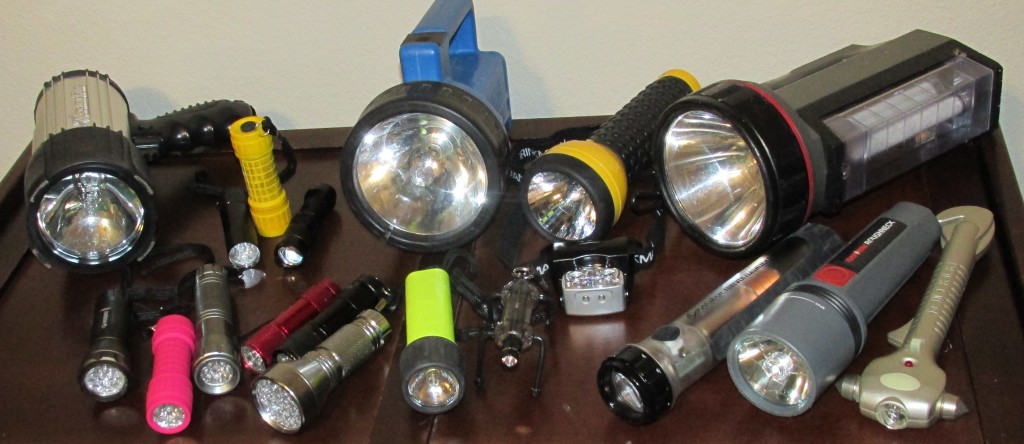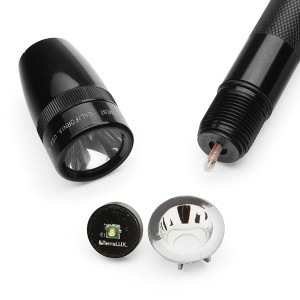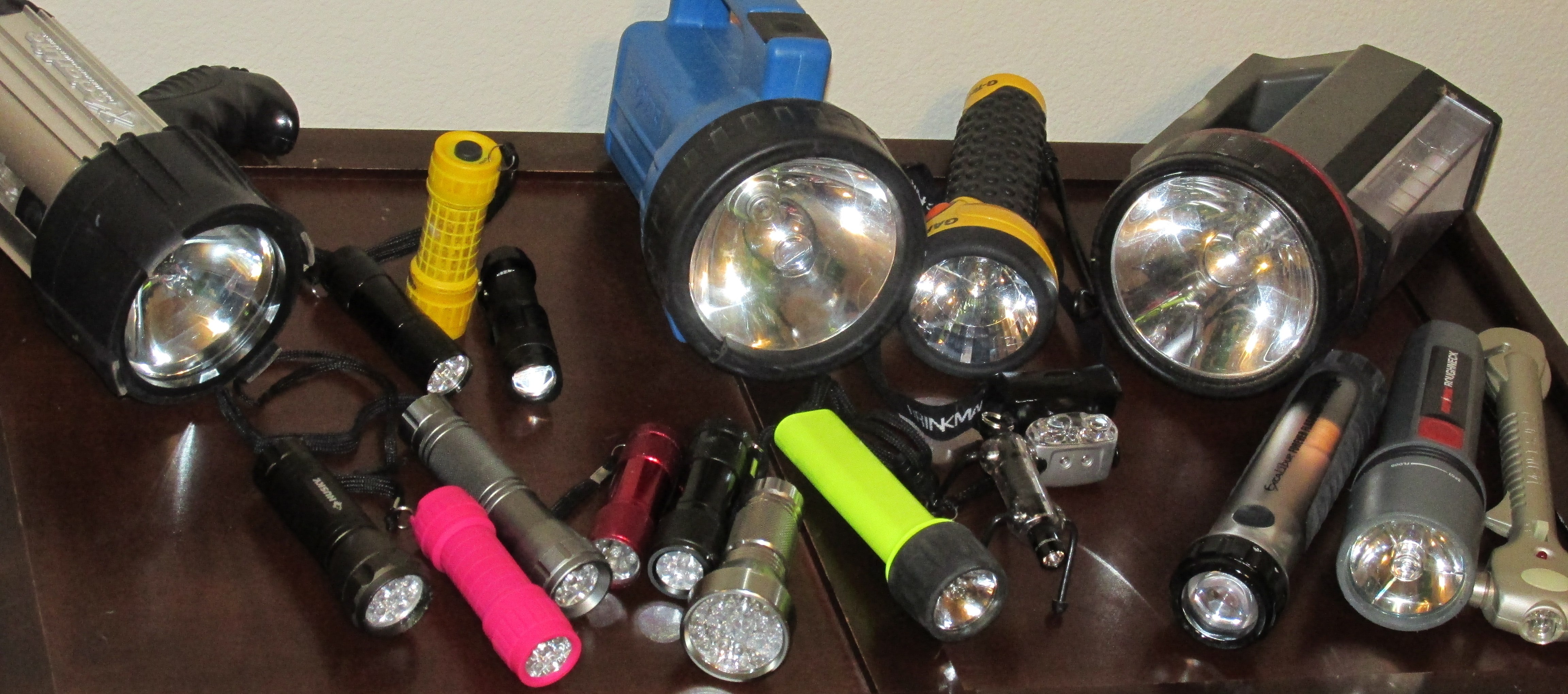tool (noun)
“an implement, especially one held in the hand, as a hammer, saw, or file, for performing or facilitating mechanical operations”
Ultimate tool (Rick’s definition)
Whatever it takes to simply, quickly and economically complete a task. This can be a specialty tool or simply a coin, knife, screwdriver, hammer or pair of pliers. For some tasks, it may be a cell phone and/or money to have someone else complete the task.
An “ultimate tool” is ready when you need it. This means it needs no preparation before using it; it stores in a convenient place and is appropriate for the task. It causes no damage while using it, it is clean and can be immediately put back into storage when the task is completed.
You have probably seen one of the recent ads for the “Ultimate Flashlight”. This is not a unique item. A Google search for “ultimate flashlight” returns well over 2 million results! Different ideas of “ultimate” have produce products ranging in price from $7.50 to over $200.
I happen to like flashlights but I’ve never had the urge to spend $250 on one. I have purchased and personalized flashlights as gifts for friends and family members. This is not an exciting gift, but is appropriate for a practical gift giver like myself. I’ve given my younger daughter several flashlights and yet I’m always looking for one that might better fit her personality and lifestyle.

Obviously, I have thought more about flashlights than the average person. Since I have not found an especially interesting question in today’s mail from readers, I’m clearing my mind of flashlight thoughts by writing:
INTO THE LIGHT
Searching for the ultimate flashlight
Have you ever explored an underground cave? As a tourist, you may have visited Carlsbad Caverns in Texas or Mammoth Cave in Kentucky. Most people are awed by the size and beauty of the caves.
At some point during the tour, the guide shows you an old skeleton. “Probably a Native American who got lost when his torch burned out while exploring the cave. He would have been cast into total darkness.: To emphasize the point, the guide tells everyone to stand still and then…they turn off the lights! Your mind races. You had already been shown the “bottomless” pits, slippery slopes and dead-end passages; you dare not move. If you were by yourself in this situation, you might panic, scream, cry, pray and desperately try to remember the path that brought you here.
My first thought: “A good flashlight would be a valuable tool to have right now.” Yeah, I’m a practical guy.
If you are an X-Files fan, you probably noticed that Mulder and Scully spent a lot of time in dark, creepy places. Out of the suit coat pockets of the F.B.I. agents came their trusty flashlights. I never saw them put new batteries in the flashlights. I don’t recall the flashlights falling out of their pockets when the agents were being attacked or tossed about during the daytime. There was never any dialog wasted on topics like corroded batteries, krypton bulbs or waterproof switches. Flashlights were just an accepted, reliable prop until the script called for them to lose power or be dropped through a grate in the floor. Of course, these may have been overpriced, government issued flashlights.
Partial darkness can enhance some experiences: meditation and sleep, lovemaking, movie watching, star gazing and disco dancing? But prolonged, total darkness is…blindness. It severs one of our strongest connections to the world around us. This is usually not a pleasant experience.
so, since the discovery of fire, we have tried to find ways to cast light into the darkness. Campfires, torches, oil lamps, gas lights, the incandescent electric powered light bulb, chemical “glo-sticks and now L.E.D. bulbs have been our artificial sunlight.
Lost in that pitch black cavern, I’m sure you would have been thrilled to have a burning stick to light your path back to the surface. But what would you really like to have? Maybe, “the ultimate flashlight”?
The cost factor is important but maybe we should concentrate on other features first. When I was a boy, you could buy a plastic flashlight with two “heavy duty” D-size batteries for $1.50. Now I see flashlights in retail stores for $50, $60 and even $80 and online for up to $250! Maybe Mulder and Skully could put those on their expense accounts but that’s not going to happen in the Perkins household.
Ultimate Flashlight Features
#1 Reliability
Isn’t it maddening when you really need a flashlight, open the glove compartment in your car, pull out the flashlight and it is dead?
#2 Functionality
Have you ever tried to walk through the woods at night with a flashlight that is too weak or unfocussed to safely light the path right in front of you?
#3 A distant third might be Styling
If the only purpose of an automobile is to transport you from one place to another, the color of the car, shape of the grill and the curves of the bodywork shouldn’t be an issue. But of course, we know differently. The same is true for our ultimate flashlight.
Let’s look at some details.
Power source/power consumption
Since we don’t have miniature cold fusion reactors, we seem to be stuck with batteries to store the energy required to light the bulb(s) in our flashlight. Even if it is solar powered or mechanically created, the energy must be stored so it is ready to use when we need it. All batteries eventually die. As long as that is true, a custom shaped or proprietary battery is really not a practical component. Standard sized AAA, AA, C and D batteries make sense because they are usually available in any modern populated area. But there are still decisions to be made. Rechargeable batteries are good for flashlights used frequently. Lithium batteries have the lowest self-discharging rate of any chemical batteries so they are good for infrequently used or stores flashlights. For frequently used flashlights, Consumer Reports recommends the top-scoring alkaline battery, Duracell Quantum which scored almost as well as the top scoring lithiums for less than half the cost. http://www.consumerreports.org/cro/batteries/buying-guide.htm
If cost is not an issue with you, lithiums are more stable (longer shelf life) and don’t contain a corrosive liquid. http://www.consumerreports.org/cro/news/2014/10/batteries-that-last-when-you-need-them/index.htm One last comment about batteries: They can add the majority of the weight to a flashlight. If you are a night watchman and consider your flashlight to also be a weapon, six D sized batteries in the appropriate flashlight makes sense. But if you want to drop it in your pants pocket or purse, not the right choice.
Every flashlight manufacturer wants to tell you they have a “bright” flashlight. You may have heard of “lumens” used as a measure of light. So the more lumens listed the brighter the light. But nothing ever seems to be simple. There are Emitter Lumens, the potential output of the emitter itself and Torch Lumens, what actually makes it out the front of the flashlight. Many retail package labels will only list the brightness in Lumens and not where the brightness was measured. For a quick comparison, a 4000 lumen flashlight may cost $200 and can start a fire with its beam.
A two D-cell flashlight using a common prefocus-style miniature lamp will produce on the order of 15 to 20 lumens. Light output from LED flashlights varies even more widely than for incandescent lights. Lights using a single 5 mm LED, may only produce a couple of lumens. Even a small LED flashlight operating on an AA cell but equipped with a power LED can emit 100 lumens. The most powerful LED flashlights produce more than one thousand lumens and may use multiple power LEDs. 100 lumens is generally acceptable for household use.
We know we want a reliable power source and bright bulb(s) for our basic flashlight. What else?
Size, shape, balance and barrel grip.
Individual preferences. For instance, if the barrel is round, I want a flat bar somewhere along the circumference so that it won’t roll when you set it down. It is nice to have a blank flat spot on the barrel or endcap so that it can be personalized with my name or initials. I like to have a removeable endcap for the batteries in addition to the lens and bulb. Just in case the alkaline batteries leak, I want to be able to open both ends of the barrel in order to knock them out. I like a rubber type grip as long as it won’t turn to sticky tar after a few years in the Texas heat.
Material
We are basically limited to plastic or aluminum. Heavy duty rubberized plastic is quieter and may be safer for electricians and less likely to scratch a polished surface if you drop it. But the aluminum barrels can take a lot of abuse and seem to survive longer.
Lens
Can be a simple clear piece of glass or plastic that keeps dust and moisture away from the reflector and bulb. Or it can be curved to magnify or focus the beam. Plastic usually gets scratched or discolored over the years while glass can shatter. Some manufacturer is probably using Gorrila Glass or something similar but I haven’t seen it.
Color Lenses or LEDs
Red and green are the most common and sometimes used in a “stealth mode”. Frankly, I have never used them and find them to be a nuisance.
Type of switch
I want to hear a positive “click” when I turn the flashlight on or off. Not a slider switch or rotate the head type of switch.
Fixed or variable focus beam
This can be a helpful feature if it is easily changed and stable once set.
Waterproof and floatable?
O-rings or other seals to keep moisture out is a must-have. Floatable is more important for a fisherman, boater or pool cleaner, etc.
Straps, brackets and magnets
I don’t want to lose my flashlight if I slip and fall on a slippery hiking path so I like to have a wrist strap option. Rings or large holes for carbineer clips can be helpful to clip the light to a belt loop or backpack. I have never been a fan of belt clips. They either slip off or hold the flashlight so close that it pokes at you while you walk. Strong magnets can be useful for holding the light in place on metal surfaces or storing it in the lid of a metal tool box or car trunk.
So what is the Ultimate Flashlight? I hate to give you a lame answer here. Remember the “pitch black cavern” scenario? The Ultimate Flashlight is the one in your hand that turns on, provides enough light and remains on long enough for you to walk out of the cave.
Interesting Project
This is my vey old Mini MagLite (from the 1980’s). It is six inches long, uses two AA batteries, has an adjustable focus beam, knurled grip and hole in endcap for a wrist strap. The caps are sealed with o-rings and it is made in the U.S.A. It seems to be a pretty good basic flashlight that could easily be the one that Mulder and Skully used. It will roll if the wrist strap is not attached and you need to twist the head to turn it on and off. But the biggest problem? It has a krypton bulb and  only produces about 5-10 lumens and rapidly depletes the batteries. So how about an upgrade? You can search the Internet for “Mini MagLite conversion kit”. I found kits that raise the light output to 30, 50 or a whopping 140 lumens! Most contain a new reflector and high output LED bulb. Example: TerraLUX™ TLE-5EX MiniStar2 Extreme LED Conversion Kit for 2 AA Mini MagLite®
only produces about 5-10 lumens and rapidly depletes the batteries. So how about an upgrade? You can search the Internet for “Mini MagLite conversion kit”. I found kits that raise the light output to 30, 50 or a whopping 140 lumens! Most contain a new reflector and high output LED bulb. Example: TerraLUX™ TLE-5EX MiniStar2 Extreme LED Conversion Kit for 2 AA Mini MagLite®
To be honest, I would only upgrade this for sentimental reasons. So many new, high powered LED flashlights have been introduced that the prices have come down to the cost of a Mini MagLite upgrade kit.
upgrade kit.
